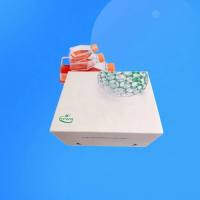Dendritic cells (DCs) are powerful antigen-presenting cells that have the unique capacity to stimulate naive T-cells (1 , 2 ). DCs are identified by a triad of criteria: Morphologically , they exhibit pronounced cytoplasmic veils that are mobile and can easily be observed under a phase-contrast microscope. These veils become apparent only in the mature state. Phenotypically , they express high levels of major histocompatibility class (MHC) (class I and II), adhesion (CD11c, CD54, CD58), and costimulatory (CD80, CD86, CD40) molecules on their cell surfaces. They also express CD1a and CD83, but lack CD14. On cytocentrifuge smears stained with anti-CD68, a marker of the endocytic system that is abundant in macrophages, DCs display spotlike staining whereas typical macrophages are strongly positive all over the cytoplasm. When looking at forward/side scatter profiles in the fluorescence-activated cell sorter (FACS), DCs show high light scattering and are outside the typical lymphocyte gate. Functionally , they are potent stimulators of resting T lymphocytes in the allogeneic mixed leukocyte reaction. DCs derived from various tissues have been shown to undergo a complex maturation process during which their morphology, phenotype, and function change. DCs are derived from bone marrow progenitors and circulate in the blood as immature precursors before they migrate into peripheral tissues, such as the epidermis, heart, lung, liver, gut, thymus, spleen, and lymph nodes. DCs of myeloid as well as of lymphoid origin have been described (3 –5 ).






